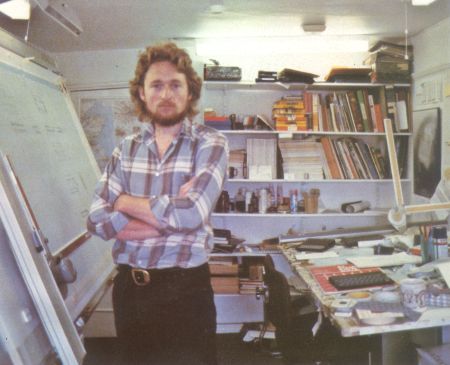| inside sinclair |

Claudia Cooke talks to Rick Dickinson, Sinclair industrial designer, who won a Design Council award for the
AWARD-WINNING industrial designer Rick Dickinson is modest about his achievements, which so far include the ZX-81, for which he won a Design Council award, and the Spectrum.
"I don't think I have ever been delighted with anything I have done", says this blond, 26-year-old prodigy. "There always seems to be room for improvement".
Dickinson is a meticulous worker and while both the ZX-81 and the Spectrum are selling beyond all expectations, he adds: "I would never let anything go to production unless I was happy with it".
Graduating from the Newcastle Polytechnic pioneering industrial design course, Dickinson and his classmates are equipped, theoretically, to design anything "from knives and forks to ocean tankers".
Dickinson produced items as diverse as a chain saw and a road tanker during his first year as a qualified industrial designer, which he spent freelancing in Wales.
He had already spent some time working for Clive Sinclair while he was studying for his degree and it was not long before he was absorbed as a full-time member of staff and the company's' sole industrial designer. He is responsible for the appearance of Sinclair products down to the layout of the components inside and the pattern of information on the keyboards. His membrane keyboard for the ZX-81 was revolutionary and largely responsible for the low retail price of the product.
Dickinson has learned that price is the ultimate justification and on all his designs he has to bear in mind the cost factor as well as the straightforward appearance of any item.
The membrane keyboard was a great success and Sinclair has had to cope with numerous pirate copies since its inception but, as with everything, it had its disadvantages. Its main disadvantage was its inability to register touch. To ensure you have a response it is necessary to look at the screen - there is no reassuring click when you touch each key.
For the Spectrum, Dickinson has returned to a raised keyboard but again he has produced a first by making it from rubber.
He says: "I like the Spectrum much more than the ZX-81. It was much quicker to design but much more complicated. It is a step upmarket and I was really trying hard for a super-smart machine. It is not for quite the same amateur market".
The process of design is a long one. Normally it begins when Clive Sinclair outlines his idea to Dickinson, including his demands about size. "He will resolve in his own mind the specifications and he will always say how small it has to be. I think how can it be that small? Yet he is always right in the end and we produce something which seemed impossible to me in the beginning".
Armed with his brief, Dickinson then spends a few days with his sketchbook, exploring ideas, but he likes to begin work in three dimensions as quickly as possible and is soon modelling in Perspex or plasticine.
The next stage is to produce the finished model in Perspex but obviously it has no components inside - it is produced as a solid block.
That model is detailed, even down to the graphics which Dickinson has painted on. Layout of the interior follows, with the designer using all his powers of logic to ensure that each component is in the best possible place. Perhaps the most difficult part is the keyboard. Dickinson says: "We spent a great deal of time on that. It is the only interface between the user and the product and it has to be right. We were trying also to cram on more information than anyone had ever done. I believe that form should follow function".
| 'That is the exciting thing in this company; many products are the first of their type so you are in on something new.' |
Design of the ZX-81 took about six months in all. The Spectrum was quicker but with all his major projects Dickinson also has to set aside time for add-ons to existing computers - the work is never finished. His main project now is the flat-tube TV, expected to be launched later this year.
His biggest problem with that is that Sinclair has already been working on it for some time. Normally he is briefed at the same time as the electronic engineers but this time the inside is already finished. It is also another first, which means Dickinson cannot research by looking at existing products in the field.
"That is the most exciting thing with this company, you know; many products are the first of their type, so you are really in on something new".
Dickinson is content with his life at the moment in every way. At school he liked the sciences and the arts and his job ensures that he remains involved in both. He spent one year on a foundation course at art college at Grimsby before starting to read for his degree and feels the experience was invaluable. He is happy with his work at Sinclair. When he started almost three years ago the staff numbered five. Today it is 30 and the company is going from strength to strength, crushing the effects of the recession as it marches on.
"We all work very closely, very much as a team. Most of the information is in people's heads. There is no time to be formal and put it down on paper. It is a good atmosphere in which to work".
For this award-winning Yorkshireman, it abounds with opportunity, too. He has already entered the Spectrum for this year's Design Council awards and on his drawing board are the initial stages of the flat-tube TV - another first, and possibly another award.